Leadership, Recruitment, and Teamwork in Business Report
VerifiedAdded on 2020/01/28
|10
|4374
|423
Report
AI Summary
This report provides an overview of leadership in business organizations, covering topics such as recruitment, employee motivation, leadership styles, and teamwork. The report begins with a documentation plan for employee selection and recruitment, emphasizing legal and ethical considerations. It then explores the skills required for leadership, the differences between management and leadership, and various leadership styles, including strategic and transformational approaches. The report also discusses methods for motivating employees to achieve organizational goals. Furthermore, it delves into the benefits of teamwork, the role of a team leader, and the assessment of work performance. The report concludes with an evaluation of the assessment process and the author's contribution to the selection process. Overall, the report aims to provide insights into effective leadership and management practices within a business context.
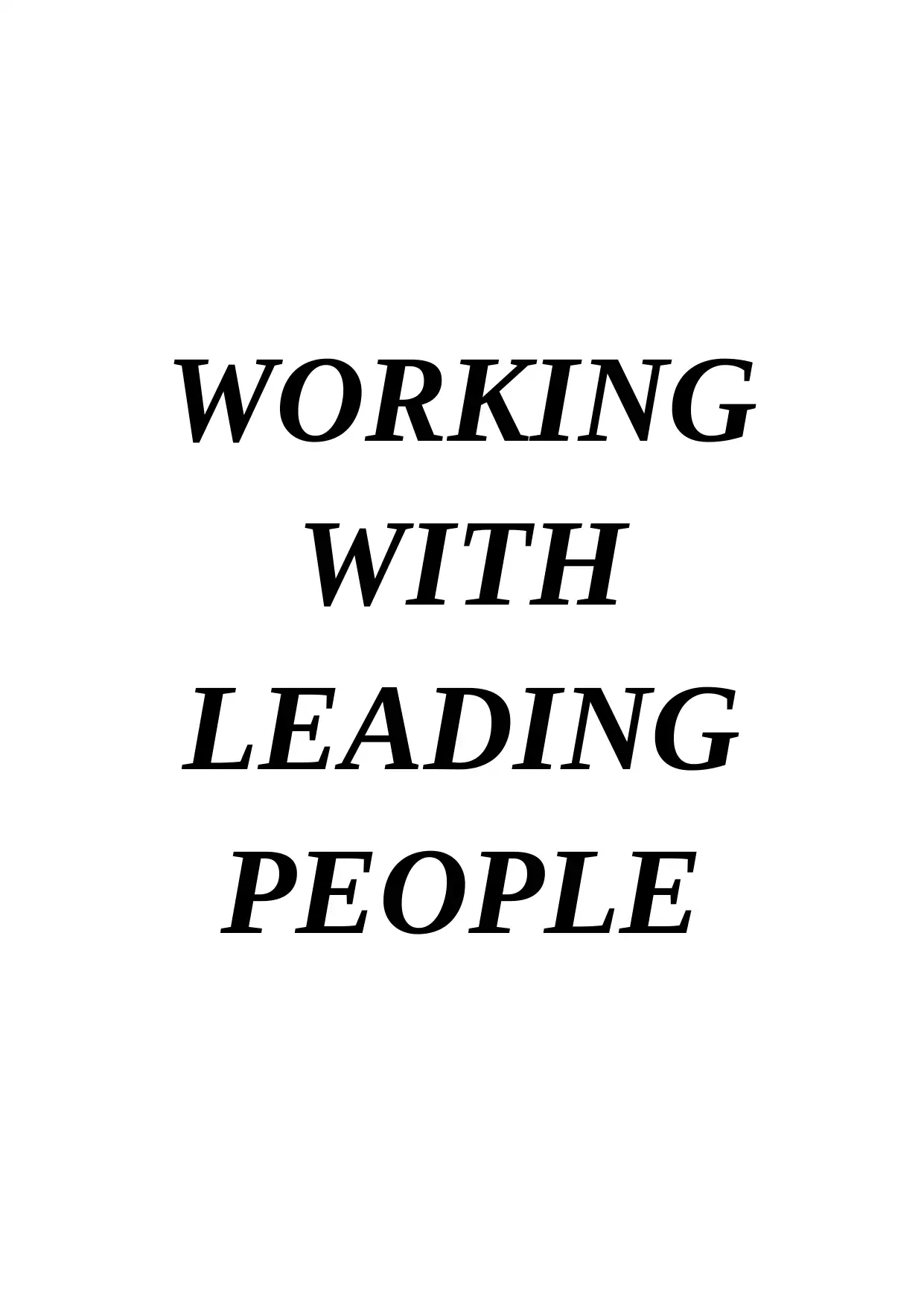
WORKING
WITH
LEADING
PEOPLE
WITH
LEADING
PEOPLE
Paraphrase This Document
Need a fresh take? Get an instant paraphrase of this document with our AI Paraphraser
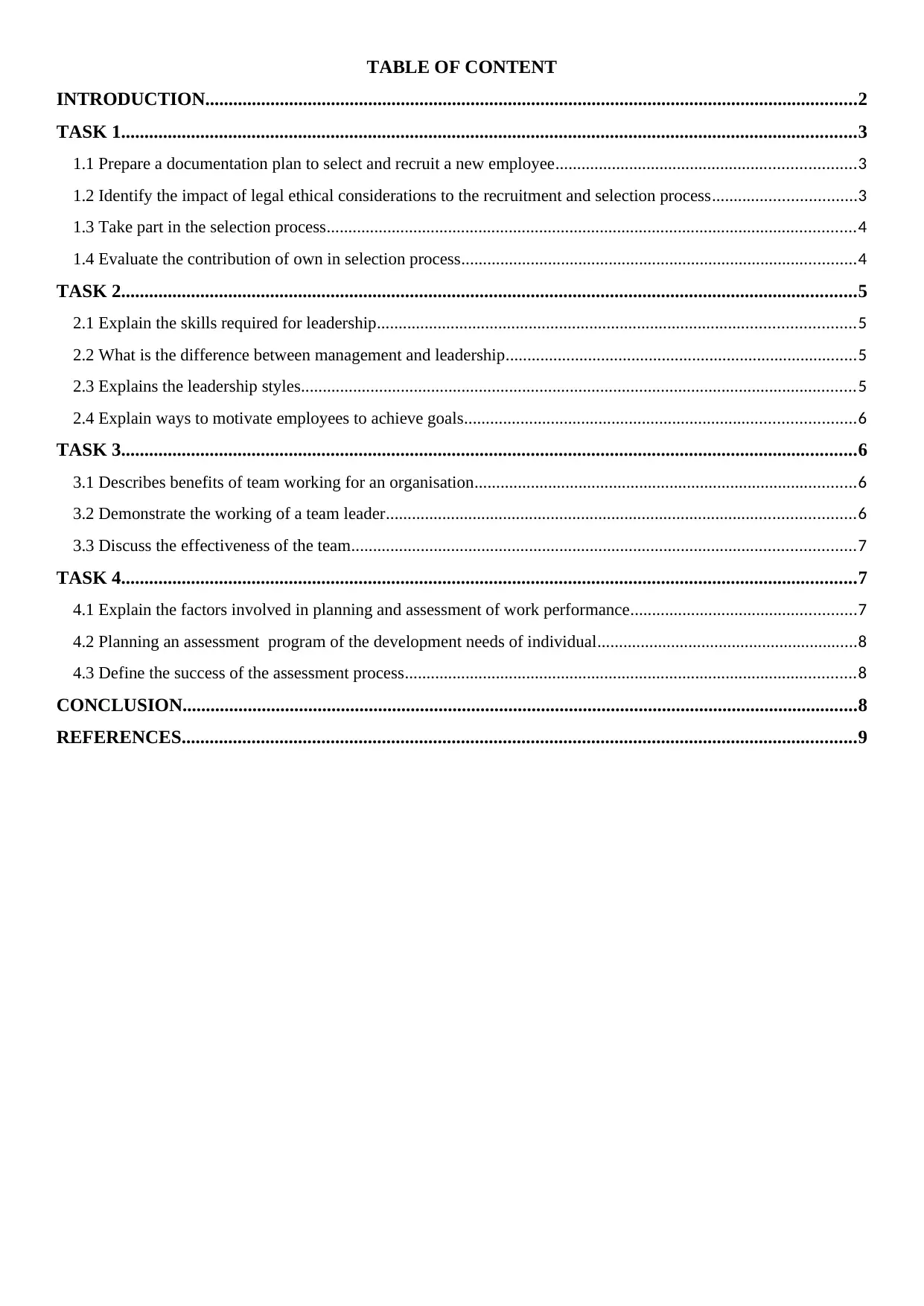
TABLE OF CONTENT
INTRODUCTION............................................................................................................................................2
TASK 1..............................................................................................................................................................3
1.1 Prepare a documentation plan to select and recruit a new employee.....................................................................3
1.2 Identify the impact of legal ethical considerations to the recruitment and selection process.................................3
1.3 Take part in the selection process..........................................................................................................................4
1.4 Evaluate the contribution of own in selection process...........................................................................................4
TASK 2..............................................................................................................................................................5
2.1 Explain the skills required for leadership..............................................................................................................5
2.2 What is the difference between management and leadership.................................................................................5
2.3 Explains the leadership styles................................................................................................................................5
2.4 Explain ways to motivate employees to achieve goals..........................................................................................6
TASK 3..............................................................................................................................................................6
3.1 Describes benefits of team working for an organisation........................................................................................6
3.2 Demonstrate the working of a team leader............................................................................................................6
3.3 Discuss the effectiveness of the team....................................................................................................................7
TASK 4..............................................................................................................................................................7
4.1 Explain the factors involved in planning and assessment of work performance....................................................7
4.2 Planning an assessment program of the development needs of individual............................................................8
4.3 Define the success of the assessment process........................................................................................................8
CONCLUSION.................................................................................................................................................8
REFERENCES.................................................................................................................................................9
INTRODUCTION............................................................................................................................................2
TASK 1..............................................................................................................................................................3
1.1 Prepare a documentation plan to select and recruit a new employee.....................................................................3
1.2 Identify the impact of legal ethical considerations to the recruitment and selection process.................................3
1.3 Take part in the selection process..........................................................................................................................4
1.4 Evaluate the contribution of own in selection process...........................................................................................4
TASK 2..............................................................................................................................................................5
2.1 Explain the skills required for leadership..............................................................................................................5
2.2 What is the difference between management and leadership.................................................................................5
2.3 Explains the leadership styles................................................................................................................................5
2.4 Explain ways to motivate employees to achieve goals..........................................................................................6
TASK 3..............................................................................................................................................................6
3.1 Describes benefits of team working for an organisation........................................................................................6
3.2 Demonstrate the working of a team leader............................................................................................................6
3.3 Discuss the effectiveness of the team....................................................................................................................7
TASK 4..............................................................................................................................................................7
4.1 Explain the factors involved in planning and assessment of work performance....................................................7
4.2 Planning an assessment program of the development needs of individual............................................................8
4.3 Define the success of the assessment process........................................................................................................8
CONCLUSION.................................................................................................................................................8
REFERENCES.................................................................................................................................................9
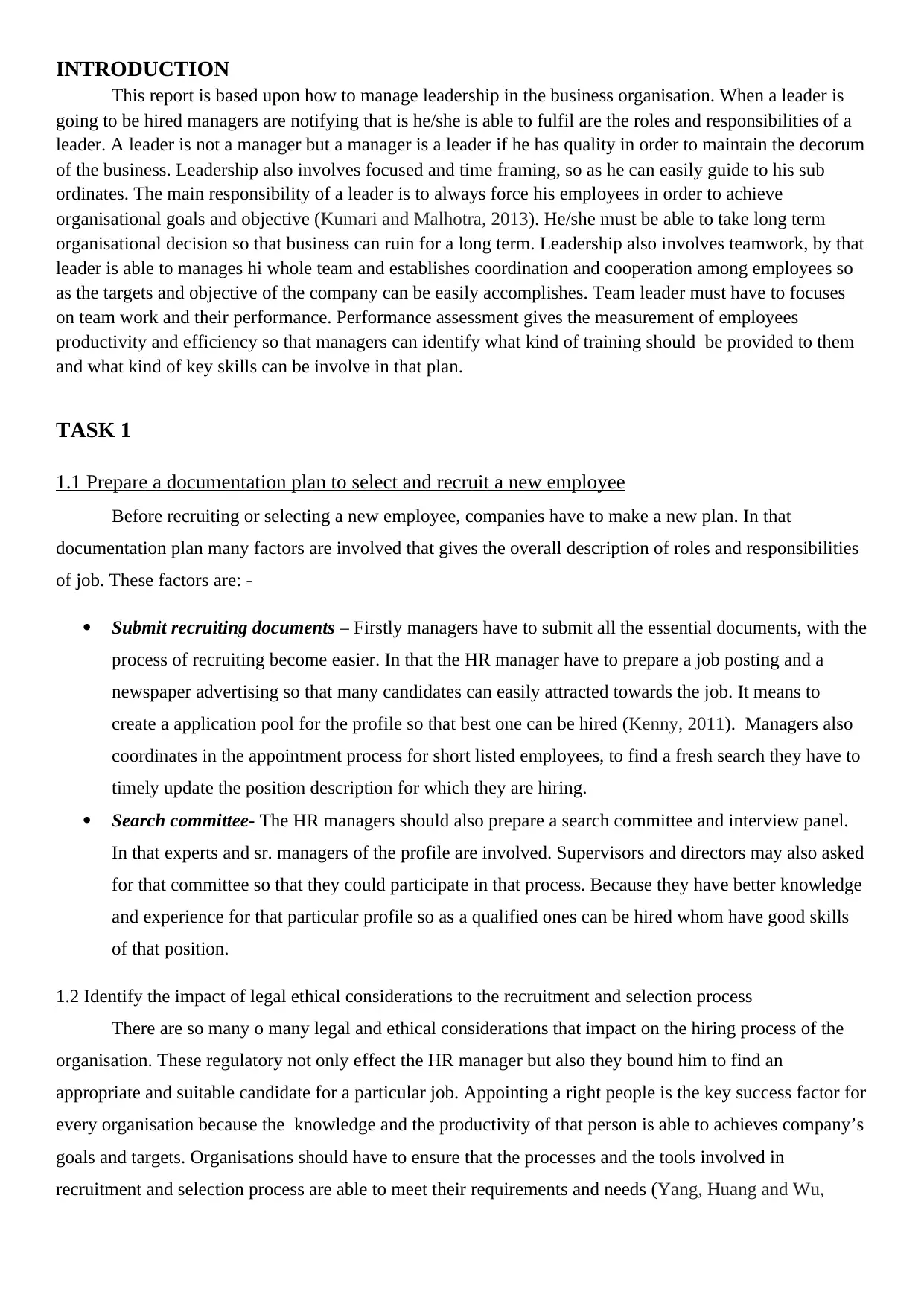
INTRODUCTION
This report is based upon how to manage leadership in the business organisation. When a leader is
going to be hired managers are notifying that is he/she is able to fulfil are the roles and responsibilities of a
leader. A leader is not a manager but a manager is a leader if he has quality in order to maintain the decorum
of the business. Leadership also involves focused and time framing, so as he can easily guide to his sub
ordinates. The main responsibility of a leader is to always force his employees in order to achieve
organisational goals and objective (Kumari and Malhotra, 2013). He/she must be able to take long term
organisational decision so that business can ruin for a long term. Leadership also involves teamwork, by that
leader is able to manages hi whole team and establishes coordination and cooperation among employees so
as the targets and objective of the company can be easily accomplishes. Team leader must have to focuses
on team work and their performance. Performance assessment gives the measurement of employees
productivity and efficiency so that managers can identify what kind of training should be provided to them
and what kind of key skills can be involve in that plan.
TASK 1
1.1 Prepare a documentation plan to select and recruit a new employee
Before recruiting or selecting a new employee, companies have to make a new plan. In that
documentation plan many factors are involved that gives the overall description of roles and responsibilities
of job. These factors are: -
Submit recruiting documents – Firstly managers have to submit all the essential documents, with the
process of recruiting become easier. In that the HR manager have to prepare a job posting and a
newspaper advertising so that many candidates can easily attracted towards the job. It means to
create a application pool for the profile so that best one can be hired (Kenny, 2011). Managers also
coordinates in the appointment process for short listed employees, to find a fresh search they have to
timely update the position description for which they are hiring.
Search committee- The HR managers should also prepare a search committee and interview panel.
In that experts and sr. managers of the profile are involved. Supervisors and directors may also asked
for that committee so that they could participate in that process. Because they have better knowledge
and experience for that particular profile so as a qualified ones can be hired whom have good skills
of that position.
1.2 Identify the impact of legal ethical considerations to the recruitment and selection process
There are so many o many legal and ethical considerations that impact on the hiring process of the
organisation. These regulatory not only effect the HR manager but also they bound him to find an
appropriate and suitable candidate for a particular job. Appointing a right people is the key success factor for
every organisation because the knowledge and the productivity of that person is able to achieves company’s
goals and targets. Organisations should have to ensure that the processes and the tools involved in
recruitment and selection process are able to meet their requirements and needs (Yang, Huang and Wu,
This report is based upon how to manage leadership in the business organisation. When a leader is
going to be hired managers are notifying that is he/she is able to fulfil are the roles and responsibilities of a
leader. A leader is not a manager but a manager is a leader if he has quality in order to maintain the decorum
of the business. Leadership also involves focused and time framing, so as he can easily guide to his sub
ordinates. The main responsibility of a leader is to always force his employees in order to achieve
organisational goals and objective (Kumari and Malhotra, 2013). He/she must be able to take long term
organisational decision so that business can ruin for a long term. Leadership also involves teamwork, by that
leader is able to manages hi whole team and establishes coordination and cooperation among employees so
as the targets and objective of the company can be easily accomplishes. Team leader must have to focuses
on team work and their performance. Performance assessment gives the measurement of employees
productivity and efficiency so that managers can identify what kind of training should be provided to them
and what kind of key skills can be involve in that plan.
TASK 1
1.1 Prepare a documentation plan to select and recruit a new employee
Before recruiting or selecting a new employee, companies have to make a new plan. In that
documentation plan many factors are involved that gives the overall description of roles and responsibilities
of job. These factors are: -
Submit recruiting documents – Firstly managers have to submit all the essential documents, with the
process of recruiting become easier. In that the HR manager have to prepare a job posting and a
newspaper advertising so that many candidates can easily attracted towards the job. It means to
create a application pool for the profile so that best one can be hired (Kenny, 2011). Managers also
coordinates in the appointment process for short listed employees, to find a fresh search they have to
timely update the position description for which they are hiring.
Search committee- The HR managers should also prepare a search committee and interview panel.
In that experts and sr. managers of the profile are involved. Supervisors and directors may also asked
for that committee so that they could participate in that process. Because they have better knowledge
and experience for that particular profile so as a qualified ones can be hired whom have good skills
of that position.
1.2 Identify the impact of legal ethical considerations to the recruitment and selection process
There are so many o many legal and ethical considerations that impact on the hiring process of the
organisation. These regulatory not only effect the HR manager but also they bound him to find an
appropriate and suitable candidate for a particular job. Appointing a right people is the key success factor for
every organisation because the knowledge and the productivity of that person is able to achieves company’s
goals and targets. Organisations should have to ensure that the processes and the tools involved in
recruitment and selection process are able to meet their requirements and needs (Yang, Huang and Wu,
⊘ This is a preview!⊘
Do you want full access?
Subscribe today to unlock all pages.

Trusted by 1+ million students worldwide
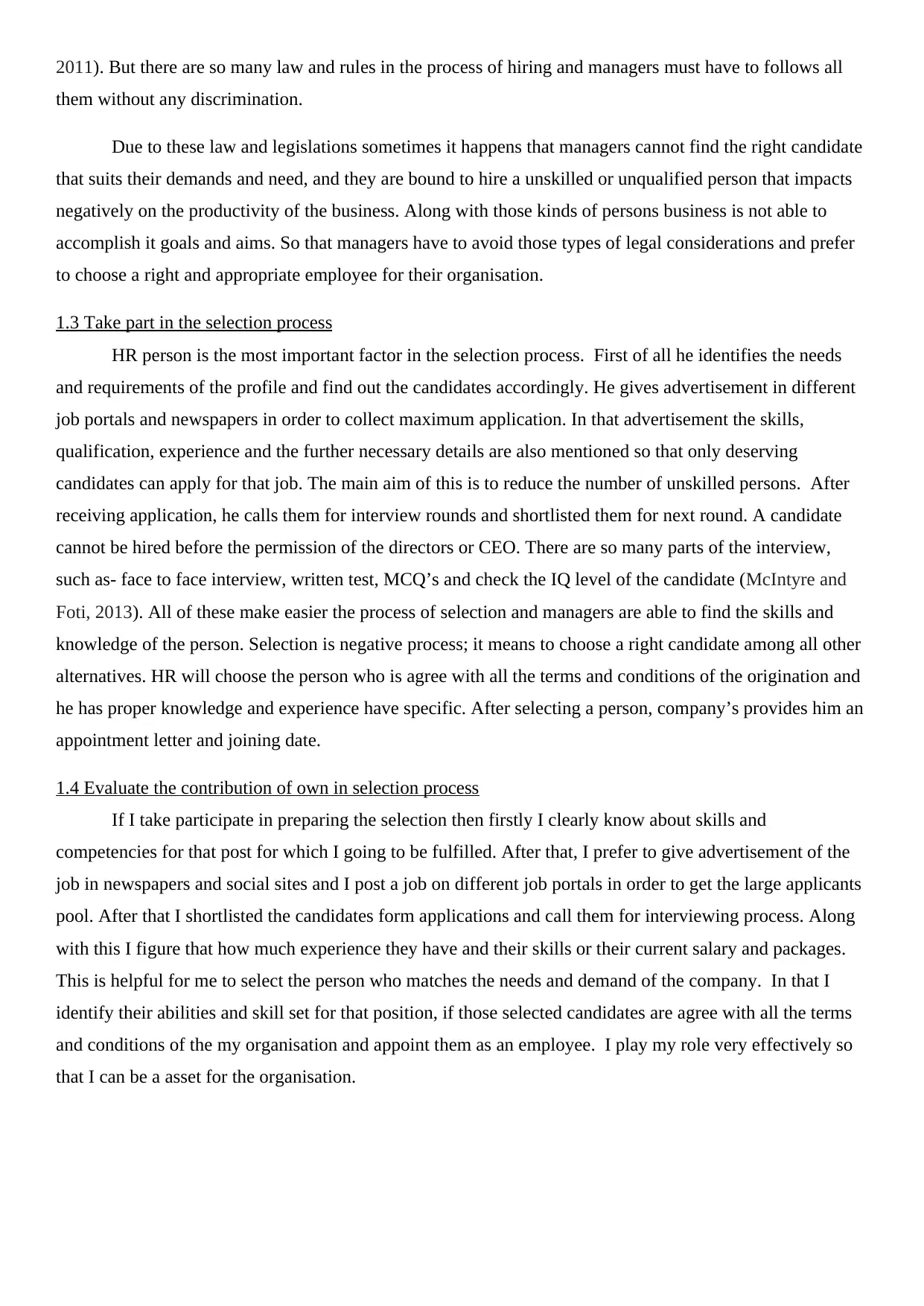
2011). But there are so many law and rules in the process of hiring and managers must have to follows all
them without any discrimination.
Due to these law and legislations sometimes it happens that managers cannot find the right candidate
that suits their demands and need, and they are bound to hire a unskilled or unqualified person that impacts
negatively on the productivity of the business. Along with those kinds of persons business is not able to
accomplish it goals and aims. So that managers have to avoid those types of legal considerations and prefer
to choose a right and appropriate employee for their organisation.
1.3 Take part in the selection process
HR person is the most important factor in the selection process. First of all he identifies the needs
and requirements of the profile and find out the candidates accordingly. He gives advertisement in different
job portals and newspapers in order to collect maximum application. In that advertisement the skills,
qualification, experience and the further necessary details are also mentioned so that only deserving
candidates can apply for that job. The main aim of this is to reduce the number of unskilled persons. After
receiving application, he calls them for interview rounds and shortlisted them for next round. A candidate
cannot be hired before the permission of the directors or CEO. There are so many parts of the interview,
such as- face to face interview, written test, MCQ’s and check the IQ level of the candidate (McIntyre and
Foti, 2013). All of these make easier the process of selection and managers are able to find the skills and
knowledge of the person. Selection is negative process; it means to choose a right candidate among all other
alternatives. HR will choose the person who is agree with all the terms and conditions of the origination and
he has proper knowledge and experience have specific. After selecting a person, company’s provides him an
appointment letter and joining date.
1.4 Evaluate the contribution of own in selection process
If I take participate in preparing the selection then firstly I clearly know about skills and
competencies for that post for which I going to be fulfilled. After that, I prefer to give advertisement of the
job in newspapers and social sites and I post a job on different job portals in order to get the large applicants
pool. After that I shortlisted the candidates form applications and call them for interviewing process. Along
with this I figure that how much experience they have and their skills or their current salary and packages.
This is helpful for me to select the person who matches the needs and demand of the company. In that I
identify their abilities and skill set for that position, if those selected candidates are agree with all the terms
and conditions of the my organisation and appoint them as an employee. I play my role very effectively so
that I can be a asset for the organisation.
them without any discrimination.
Due to these law and legislations sometimes it happens that managers cannot find the right candidate
that suits their demands and need, and they are bound to hire a unskilled or unqualified person that impacts
negatively on the productivity of the business. Along with those kinds of persons business is not able to
accomplish it goals and aims. So that managers have to avoid those types of legal considerations and prefer
to choose a right and appropriate employee for their organisation.
1.3 Take part in the selection process
HR person is the most important factor in the selection process. First of all he identifies the needs
and requirements of the profile and find out the candidates accordingly. He gives advertisement in different
job portals and newspapers in order to collect maximum application. In that advertisement the skills,
qualification, experience and the further necessary details are also mentioned so that only deserving
candidates can apply for that job. The main aim of this is to reduce the number of unskilled persons. After
receiving application, he calls them for interview rounds and shortlisted them for next round. A candidate
cannot be hired before the permission of the directors or CEO. There are so many parts of the interview,
such as- face to face interview, written test, MCQ’s and check the IQ level of the candidate (McIntyre and
Foti, 2013). All of these make easier the process of selection and managers are able to find the skills and
knowledge of the person. Selection is negative process; it means to choose a right candidate among all other
alternatives. HR will choose the person who is agree with all the terms and conditions of the origination and
he has proper knowledge and experience have specific. After selecting a person, company’s provides him an
appointment letter and joining date.
1.4 Evaluate the contribution of own in selection process
If I take participate in preparing the selection then firstly I clearly know about skills and
competencies for that post for which I going to be fulfilled. After that, I prefer to give advertisement of the
job in newspapers and social sites and I post a job on different job portals in order to get the large applicants
pool. After that I shortlisted the candidates form applications and call them for interviewing process. Along
with this I figure that how much experience they have and their skills or their current salary and packages.
This is helpful for me to select the person who matches the needs and demand of the company. In that I
identify their abilities and skill set for that position, if those selected candidates are agree with all the terms
and conditions of the my organisation and appoint them as an employee. I play my role very effectively so
that I can be a asset for the organisation.
Paraphrase This Document
Need a fresh take? Get an instant paraphrase of this document with our AI Paraphraser
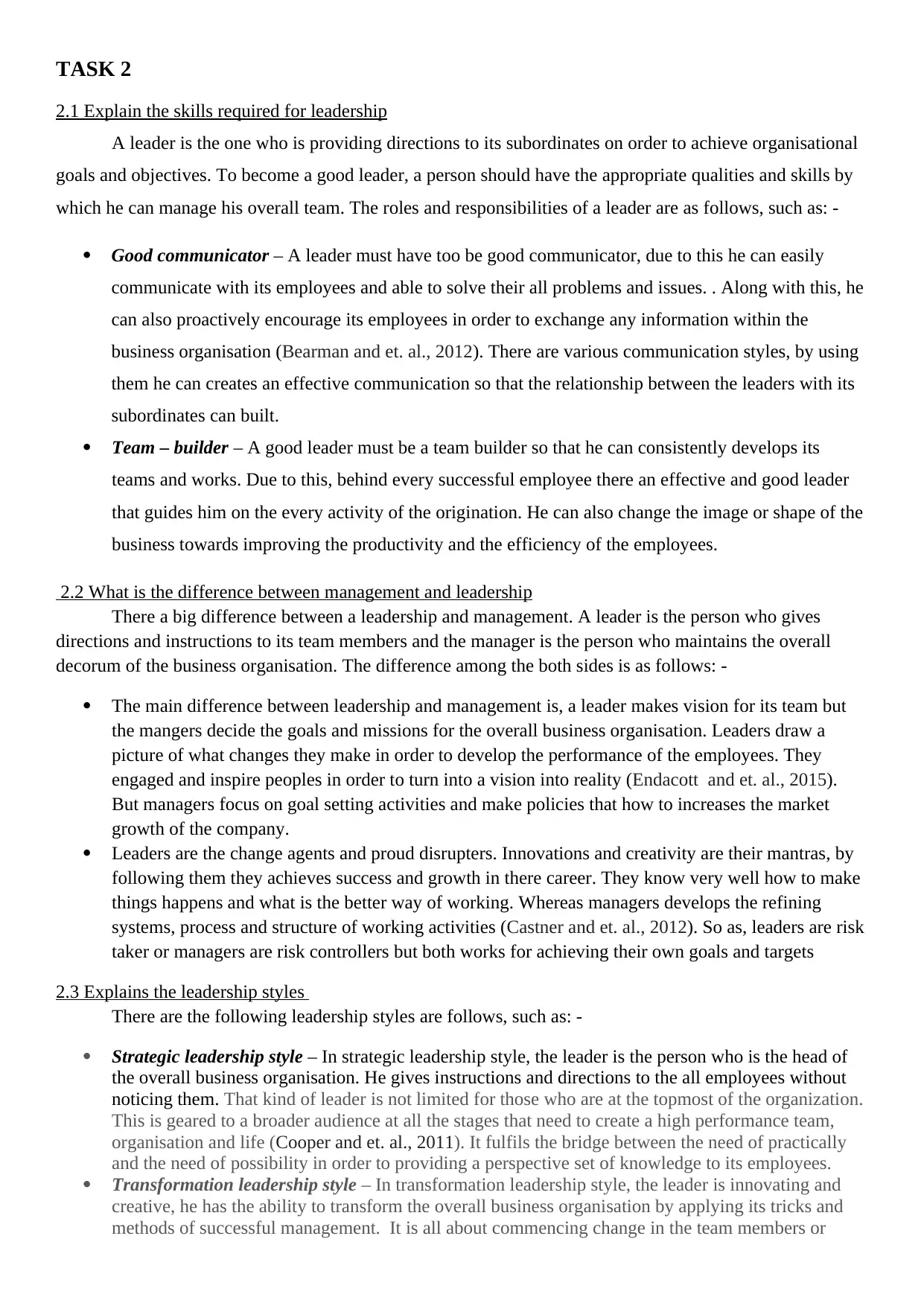
TASK 2
2.1 Explain the skills required for leadership
A leader is the one who is providing directions to its subordinates on order to achieve organisational
goals and objectives. To become a good leader, a person should have the appropriate qualities and skills by
which he can manage his overall team. The roles and responsibilities of a leader are as follows, such as: -
Good communicator – A leader must have too be good communicator, due to this he can easily
communicate with its employees and able to solve their all problems and issues. . Along with this, he
can also proactively encourage its employees in order to exchange any information within the
business organisation (Bearman and et. al., 2012). There are various communication styles, by using
them he can creates an effective communication so that the relationship between the leaders with its
subordinates can built.
Team – builder – A good leader must be a team builder so that he can consistently develops its
teams and works. Due to this, behind every successful employee there an effective and good leader
that guides him on the every activity of the origination. He can also change the image or shape of the
business towards improving the productivity and the efficiency of the employees.
2.2 What is the difference between management and leadership
There a big difference between a leadership and management. A leader is the person who gives
directions and instructions to its team members and the manager is the person who maintains the overall
decorum of the business organisation. The difference among the both sides is as follows: -
The main difference between leadership and management is, a leader makes vision for its team but
the mangers decide the goals and missions for the overall business organisation. Leaders draw a
picture of what changes they make in order to develop the performance of the employees. They
engaged and inspire peoples in order to turn into a vision into reality (Endacott and et. al., 2015).
But managers focus on goal setting activities and make policies that how to increases the market
growth of the company.
Leaders are the change agents and proud disrupters. Innovations and creativity are their mantras, by
following them they achieves success and growth in there career. They know very well how to make
things happens and what is the better way of working. Whereas managers develops the refining
systems, process and structure of working activities (Castner and et. al., 2012). So as, leaders are risk
taker or managers are risk controllers but both works for achieving their own goals and targets
2.3 Explains the leadership styles
There are the following leadership styles are follows, such as: -
Strategic leadership style – In strategic leadership style, the leader is the person who is the head of
the overall business organisation. He gives instructions and directions to the all employees without
noticing them. That kind of leader is not limited for those who are at the topmost of the organization.
This is geared to a broader audience at all the stages that need to create a high performance team,
organisation and life (Cooper and et. al., 2011). It fulfils the bridge between the need of practically
and the need of possibility in order to providing a perspective set of knowledge to its employees.
Transformation leadership style – In transformation leadership style, the leader is innovating and
creative, he has the ability to transform the overall business organisation by applying its tricks and
methods of successful management. It is all about commencing change in the team members or
2.1 Explain the skills required for leadership
A leader is the one who is providing directions to its subordinates on order to achieve organisational
goals and objectives. To become a good leader, a person should have the appropriate qualities and skills by
which he can manage his overall team. The roles and responsibilities of a leader are as follows, such as: -
Good communicator – A leader must have too be good communicator, due to this he can easily
communicate with its employees and able to solve their all problems and issues. . Along with this, he
can also proactively encourage its employees in order to exchange any information within the
business organisation (Bearman and et. al., 2012). There are various communication styles, by using
them he can creates an effective communication so that the relationship between the leaders with its
subordinates can built.
Team – builder – A good leader must be a team builder so that he can consistently develops its
teams and works. Due to this, behind every successful employee there an effective and good leader
that guides him on the every activity of the origination. He can also change the image or shape of the
business towards improving the productivity and the efficiency of the employees.
2.2 What is the difference between management and leadership
There a big difference between a leadership and management. A leader is the person who gives
directions and instructions to its team members and the manager is the person who maintains the overall
decorum of the business organisation. The difference among the both sides is as follows: -
The main difference between leadership and management is, a leader makes vision for its team but
the mangers decide the goals and missions for the overall business organisation. Leaders draw a
picture of what changes they make in order to develop the performance of the employees. They
engaged and inspire peoples in order to turn into a vision into reality (Endacott and et. al., 2015).
But managers focus on goal setting activities and make policies that how to increases the market
growth of the company.
Leaders are the change agents and proud disrupters. Innovations and creativity are their mantras, by
following them they achieves success and growth in there career. They know very well how to make
things happens and what is the better way of working. Whereas managers develops the refining
systems, process and structure of working activities (Castner and et. al., 2012). So as, leaders are risk
taker or managers are risk controllers but both works for achieving their own goals and targets
2.3 Explains the leadership styles
There are the following leadership styles are follows, such as: -
Strategic leadership style – In strategic leadership style, the leader is the person who is the head of
the overall business organisation. He gives instructions and directions to the all employees without
noticing them. That kind of leader is not limited for those who are at the topmost of the organization.
This is geared to a broader audience at all the stages that need to create a high performance team,
organisation and life (Cooper and et. al., 2011). It fulfils the bridge between the need of practically
and the need of possibility in order to providing a perspective set of knowledge to its employees.
Transformation leadership style – In transformation leadership style, the leader is innovating and
creative, he has the ability to transform the overall business organisation by applying its tricks and
methods of successful management. It is all about commencing change in the team members or
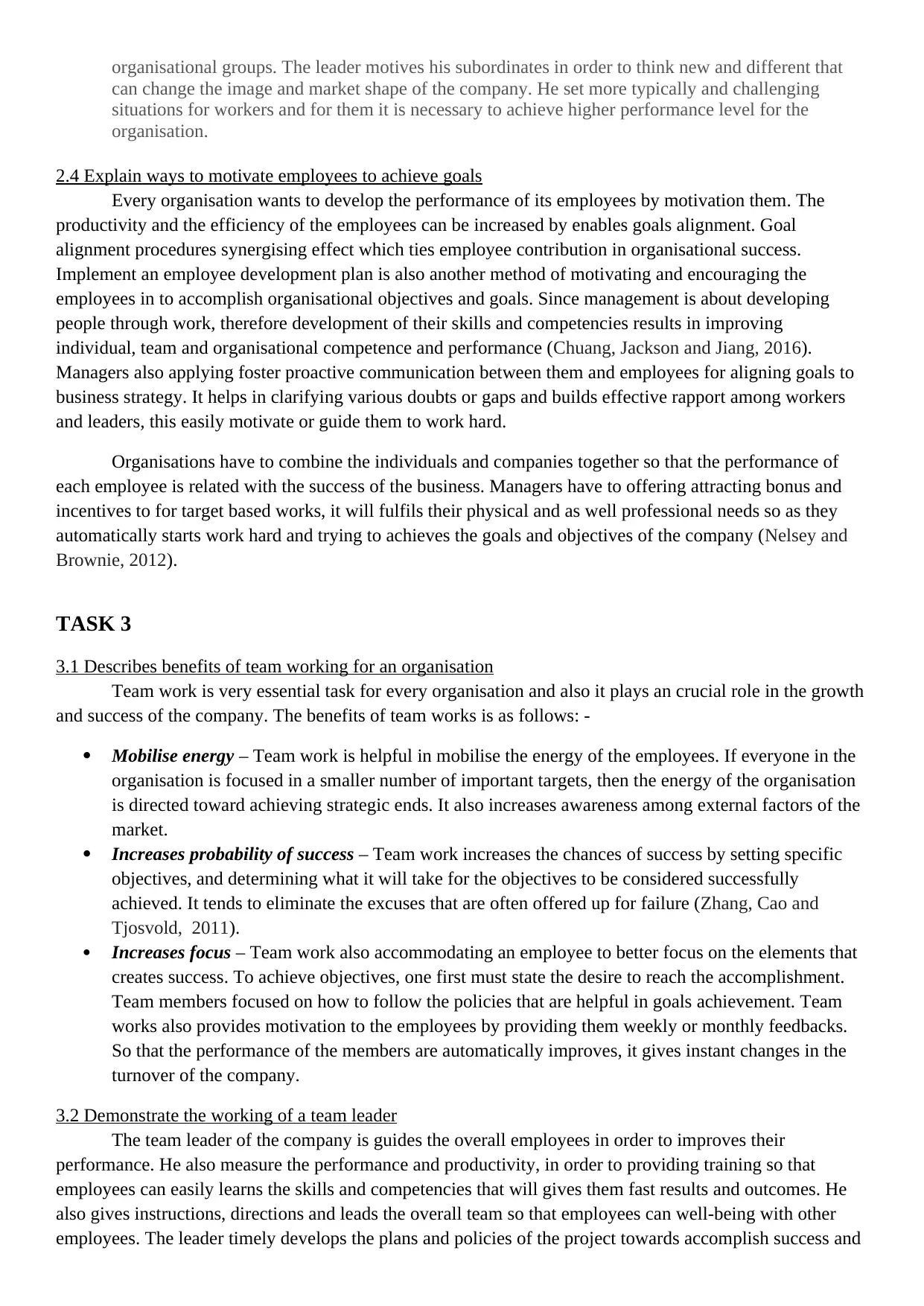
organisational groups. The leader motives his subordinates in order to think new and different that
can change the image and market shape of the company. He set more typically and challenging
situations for workers and for them it is necessary to achieve higher performance level for the
organisation.
2.4 Explain ways to motivate employees to achieve goals
Every organisation wants to develop the performance of its employees by motivation them. The
productivity and the efficiency of the employees can be increased by enables goals alignment. Goal
alignment procedures synergising effect which ties employee contribution in organisational success.
Implement an employee development plan is also another method of motivating and encouraging the
employees in to accomplish organisational objectives and goals. Since management is about developing
people through work, therefore development of their skills and competencies results in improving
individual, team and organisational competence and performance (Chuang, Jackson and Jiang, 2016).
Managers also applying foster proactive communication between them and employees for aligning goals to
business strategy. It helps in clarifying various doubts or gaps and builds effective rapport among workers
and leaders, this easily motivate or guide them to work hard.
Organisations have to combine the individuals and companies together so that the performance of
each employee is related with the success of the business. Managers have to offering attracting bonus and
incentives to for target based works, it will fulfils their physical and as well professional needs so as they
automatically starts work hard and trying to achieves the goals and objectives of the company (Nelsey and
Brownie, 2012).
TASK 3
3.1 Describes benefits of team working for an organisation
Team work is very essential task for every organisation and also it plays an crucial role in the growth
and success of the company. The benefits of team works is as follows: -
Mobilise energy – Team work is helpful in mobilise the energy of the employees. If everyone in the
organisation is focused in a smaller number of important targets, then the energy of the organisation
is directed toward achieving strategic ends. It also increases awareness among external factors of the
market.
Increases probability of success – Team work increases the chances of success by setting specific
objectives, and determining what it will take for the objectives to be considered successfully
achieved. It tends to eliminate the excuses that are often offered up for failure (Zhang, Cao and
Tjosvold, 2011).
Increases focus – Team work also accommodating an employee to better focus on the elements that
creates success. To achieve objectives, one first must state the desire to reach the accomplishment.
Team members focused on how to follow the policies that are helpful in goals achievement. Team
works also provides motivation to the employees by providing them weekly or monthly feedbacks.
So that the performance of the members are automatically improves, it gives instant changes in the
turnover of the company.
3.2 Demonstrate the working of a team leader
The team leader of the company is guides the overall employees in order to improves their
performance. He also measure the performance and productivity, in order to providing training so that
employees can easily learns the skills and competencies that will gives them fast results and outcomes. He
also gives instructions, directions and leads the overall team so that employees can well-being with other
employees. The leader timely develops the plans and policies of the project towards accomplish success and
can change the image and market shape of the company. He set more typically and challenging
situations for workers and for them it is necessary to achieve higher performance level for the
organisation.
2.4 Explain ways to motivate employees to achieve goals
Every organisation wants to develop the performance of its employees by motivation them. The
productivity and the efficiency of the employees can be increased by enables goals alignment. Goal
alignment procedures synergising effect which ties employee contribution in organisational success.
Implement an employee development plan is also another method of motivating and encouraging the
employees in to accomplish organisational objectives and goals. Since management is about developing
people through work, therefore development of their skills and competencies results in improving
individual, team and organisational competence and performance (Chuang, Jackson and Jiang, 2016).
Managers also applying foster proactive communication between them and employees for aligning goals to
business strategy. It helps in clarifying various doubts or gaps and builds effective rapport among workers
and leaders, this easily motivate or guide them to work hard.
Organisations have to combine the individuals and companies together so that the performance of
each employee is related with the success of the business. Managers have to offering attracting bonus and
incentives to for target based works, it will fulfils their physical and as well professional needs so as they
automatically starts work hard and trying to achieves the goals and objectives of the company (Nelsey and
Brownie, 2012).
TASK 3
3.1 Describes benefits of team working for an organisation
Team work is very essential task for every organisation and also it plays an crucial role in the growth
and success of the company. The benefits of team works is as follows: -
Mobilise energy – Team work is helpful in mobilise the energy of the employees. If everyone in the
organisation is focused in a smaller number of important targets, then the energy of the organisation
is directed toward achieving strategic ends. It also increases awareness among external factors of the
market.
Increases probability of success – Team work increases the chances of success by setting specific
objectives, and determining what it will take for the objectives to be considered successfully
achieved. It tends to eliminate the excuses that are often offered up for failure (Zhang, Cao and
Tjosvold, 2011).
Increases focus – Team work also accommodating an employee to better focus on the elements that
creates success. To achieve objectives, one first must state the desire to reach the accomplishment.
Team members focused on how to follow the policies that are helpful in goals achievement. Team
works also provides motivation to the employees by providing them weekly or monthly feedbacks.
So that the performance of the members are automatically improves, it gives instant changes in the
turnover of the company.
3.2 Demonstrate the working of a team leader
The team leader of the company is guides the overall employees in order to improves their
performance. He also measure the performance and productivity, in order to providing training so that
employees can easily learns the skills and competencies that will gives them fast results and outcomes. He
also gives instructions, directions and leads the overall team so that employees can well-being with other
employees. The leader timely develops the plans and policies of the project towards accomplish success and
⊘ This is a preview!⊘
Do you want full access?
Subscribe today to unlock all pages.

Trusted by 1+ million students worldwide
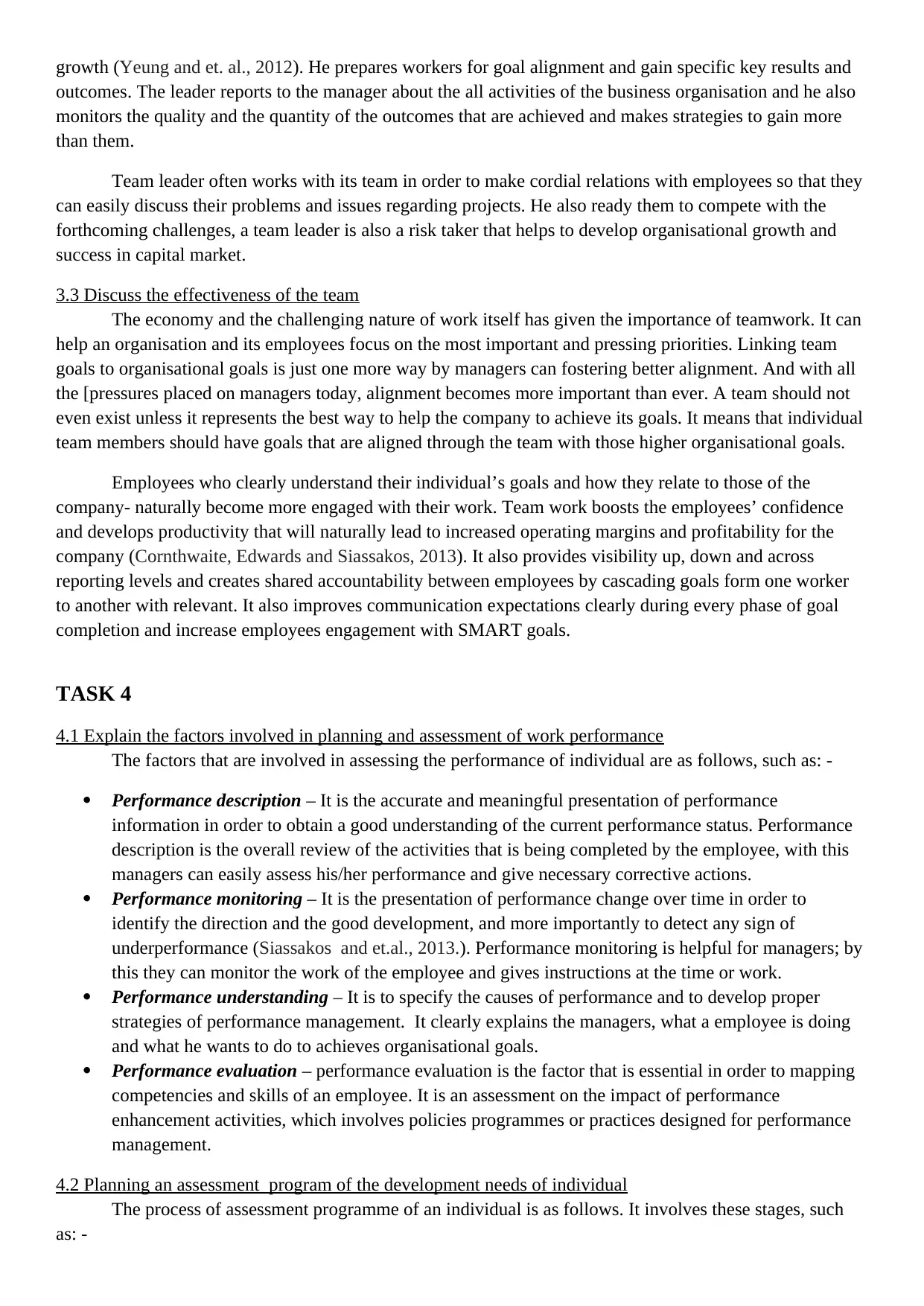
growth (Yeung and et. al., 2012). He prepares workers for goal alignment and gain specific key results and
outcomes. The leader reports to the manager about the all activities of the business organisation and he also
monitors the quality and the quantity of the outcomes that are achieved and makes strategies to gain more
than them.
Team leader often works with its team in order to make cordial relations with employees so that they
can easily discuss their problems and issues regarding projects. He also ready them to compete with the
forthcoming challenges, a team leader is also a risk taker that helps to develop organisational growth and
success in capital market.
3.3 Discuss the effectiveness of the team
The economy and the challenging nature of work itself has given the importance of teamwork. It can
help an organisation and its employees focus on the most important and pressing priorities. Linking team
goals to organisational goals is just one more way by managers can fostering better alignment. And with all
the [pressures placed on managers today, alignment becomes more important than ever. A team should not
even exist unless it represents the best way to help the company to achieve its goals. It means that individual
team members should have goals that are aligned through the team with those higher organisational goals.
Employees who clearly understand their individual’s goals and how they relate to those of the
company- naturally become more engaged with their work. Team work boosts the employees’ confidence
and develops productivity that will naturally lead to increased operating margins and profitability for the
company (Cornthwaite, Edwards and Siassakos, 2013). It also provides visibility up, down and across
reporting levels and creates shared accountability between employees by cascading goals form one worker
to another with relevant. It also improves communication expectations clearly during every phase of goal
completion and increase employees engagement with SMART goals.
TASK 4
4.1 Explain the factors involved in planning and assessment of work performance
The factors that are involved in assessing the performance of individual are as follows, such as: -
Performance description – It is the accurate and meaningful presentation of performance
information in order to obtain a good understanding of the current performance status. Performance
description is the overall review of the activities that is being completed by the employee, with this
managers can easily assess his/her performance and give necessary corrective actions.
Performance monitoring – It is the presentation of performance change over time in order to
identify the direction and the good development, and more importantly to detect any sign of
underperformance (Siassakos and et.al., 2013.). Performance monitoring is helpful for managers; by
this they can monitor the work of the employee and gives instructions at the time or work.
Performance understanding – It is to specify the causes of performance and to develop proper
strategies of performance management. It clearly explains the managers, what a employee is doing
and what he wants to do to achieves organisational goals.
Performance evaluation – performance evaluation is the factor that is essential in order to mapping
competencies and skills of an employee. It is an assessment on the impact of performance
enhancement activities, which involves policies programmes or practices designed for performance
management.
4.2 Planning an assessment program of the development needs of individual
The process of assessment programme of an individual is as follows. It involves these stages, such
as: -
outcomes. The leader reports to the manager about the all activities of the business organisation and he also
monitors the quality and the quantity of the outcomes that are achieved and makes strategies to gain more
than them.
Team leader often works with its team in order to make cordial relations with employees so that they
can easily discuss their problems and issues regarding projects. He also ready them to compete with the
forthcoming challenges, a team leader is also a risk taker that helps to develop organisational growth and
success in capital market.
3.3 Discuss the effectiveness of the team
The economy and the challenging nature of work itself has given the importance of teamwork. It can
help an organisation and its employees focus on the most important and pressing priorities. Linking team
goals to organisational goals is just one more way by managers can fostering better alignment. And with all
the [pressures placed on managers today, alignment becomes more important than ever. A team should not
even exist unless it represents the best way to help the company to achieve its goals. It means that individual
team members should have goals that are aligned through the team with those higher organisational goals.
Employees who clearly understand their individual’s goals and how they relate to those of the
company- naturally become more engaged with their work. Team work boosts the employees’ confidence
and develops productivity that will naturally lead to increased operating margins and profitability for the
company (Cornthwaite, Edwards and Siassakos, 2013). It also provides visibility up, down and across
reporting levels and creates shared accountability between employees by cascading goals form one worker
to another with relevant. It also improves communication expectations clearly during every phase of goal
completion and increase employees engagement with SMART goals.
TASK 4
4.1 Explain the factors involved in planning and assessment of work performance
The factors that are involved in assessing the performance of individual are as follows, such as: -
Performance description – It is the accurate and meaningful presentation of performance
information in order to obtain a good understanding of the current performance status. Performance
description is the overall review of the activities that is being completed by the employee, with this
managers can easily assess his/her performance and give necessary corrective actions.
Performance monitoring – It is the presentation of performance change over time in order to
identify the direction and the good development, and more importantly to detect any sign of
underperformance (Siassakos and et.al., 2013.). Performance monitoring is helpful for managers; by
this they can monitor the work of the employee and gives instructions at the time or work.
Performance understanding – It is to specify the causes of performance and to develop proper
strategies of performance management. It clearly explains the managers, what a employee is doing
and what he wants to do to achieves organisational goals.
Performance evaluation – performance evaluation is the factor that is essential in order to mapping
competencies and skills of an employee. It is an assessment on the impact of performance
enhancement activities, which involves policies programmes or practices designed for performance
management.
4.2 Planning an assessment program of the development needs of individual
The process of assessment programme of an individual is as follows. It involves these stages, such
as: -
Paraphrase This Document
Need a fresh take? Get an instant paraphrase of this document with our AI Paraphraser
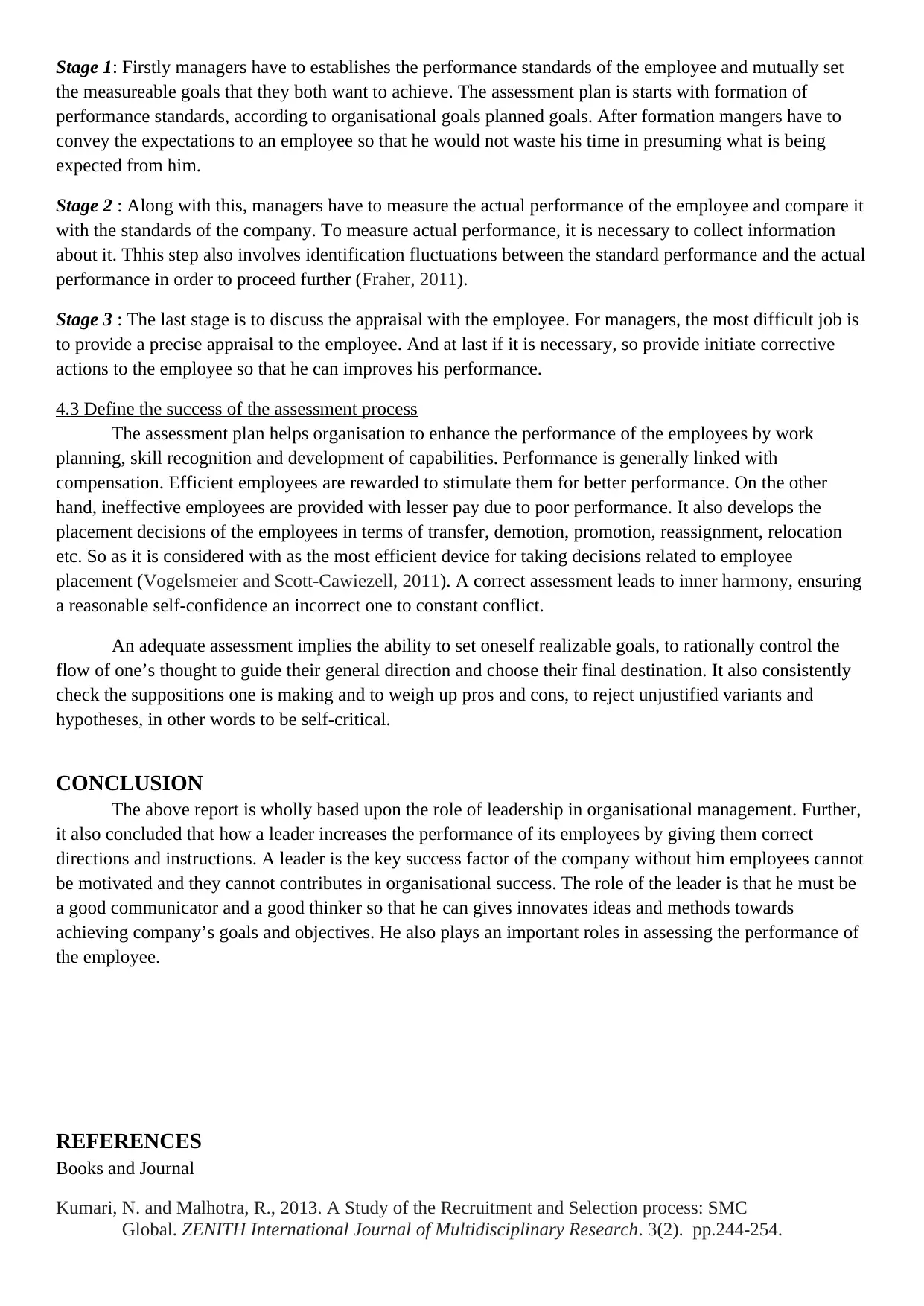
Stage 1: Firstly managers have to establishes the performance standards of the employee and mutually set
the measureable goals that they both want to achieve. The assessment plan is starts with formation of
performance standards, according to organisational goals planned goals. After formation mangers have to
convey the expectations to an employee so that he would not waste his time in presuming what is being
expected from him.
Stage 2 : Along with this, managers have to measure the actual performance of the employee and compare it
with the standards of the company. To measure actual performance, it is necessary to collect information
about it. Thhis step also involves identification fluctuations between the standard performance and the actual
performance in order to proceed further (Fraher, 2011).
Stage 3 : The last stage is to discuss the appraisal with the employee. For managers, the most difficult job is
to provide a precise appraisal to the employee. And at last if it is necessary, so provide initiate corrective
actions to the employee so that he can improves his performance.
4.3 Define the success of the assessment process
The assessment plan helps organisation to enhance the performance of the employees by work
planning, skill recognition and development of capabilities. Performance is generally linked with
compensation. Efficient employees are rewarded to stimulate them for better performance. On the other
hand, ineffective employees are provided with lesser pay due to poor performance. It also develops the
placement decisions of the employees in terms of transfer, demotion, promotion, reassignment, relocation
etc. So as it is considered with as the most efficient device for taking decisions related to employee
placement (Vogelsmeier and Scott-Cawiezell, 2011). A correct assessment leads to inner harmony, ensuring
a reasonable self-confidence an incorrect one to constant conflict.
An adequate assessment implies the ability to set oneself realizable goals, to rationally control the
flow of one’s thought to guide their general direction and choose their final destination. It also consistently
check the suppositions one is making and to weigh up pros and cons, to reject unjustified variants and
hypotheses, in other words to be self-critical.
CONCLUSION
The above report is wholly based upon the role of leadership in organisational management. Further,
it also concluded that how a leader increases the performance of its employees by giving them correct
directions and instructions. A leader is the key success factor of the company without him employees cannot
be motivated and they cannot contributes in organisational success. The role of the leader is that he must be
a good communicator and a good thinker so that he can gives innovates ideas and methods towards
achieving company’s goals and objectives. He also plays an important roles in assessing the performance of
the employee.
REFERENCES
Books and Journal
Kumari, N. and Malhotra, R., 2013. A Study of the Recruitment and Selection process: SMC
Global. ZENITH International Journal of Multidisciplinary Research. 3(2). pp.244-254.
the measureable goals that they both want to achieve. The assessment plan is starts with formation of
performance standards, according to organisational goals planned goals. After formation mangers have to
convey the expectations to an employee so that he would not waste his time in presuming what is being
expected from him.
Stage 2 : Along with this, managers have to measure the actual performance of the employee and compare it
with the standards of the company. To measure actual performance, it is necessary to collect information
about it. Thhis step also involves identification fluctuations between the standard performance and the actual
performance in order to proceed further (Fraher, 2011).
Stage 3 : The last stage is to discuss the appraisal with the employee. For managers, the most difficult job is
to provide a precise appraisal to the employee. And at last if it is necessary, so provide initiate corrective
actions to the employee so that he can improves his performance.
4.3 Define the success of the assessment process
The assessment plan helps organisation to enhance the performance of the employees by work
planning, skill recognition and development of capabilities. Performance is generally linked with
compensation. Efficient employees are rewarded to stimulate them for better performance. On the other
hand, ineffective employees are provided with lesser pay due to poor performance. It also develops the
placement decisions of the employees in terms of transfer, demotion, promotion, reassignment, relocation
etc. So as it is considered with as the most efficient device for taking decisions related to employee
placement (Vogelsmeier and Scott-Cawiezell, 2011). A correct assessment leads to inner harmony, ensuring
a reasonable self-confidence an incorrect one to constant conflict.
An adequate assessment implies the ability to set oneself realizable goals, to rationally control the
flow of one’s thought to guide their general direction and choose their final destination. It also consistently
check the suppositions one is making and to weigh up pros and cons, to reject unjustified variants and
hypotheses, in other words to be self-critical.
CONCLUSION
The above report is wholly based upon the role of leadership in organisational management. Further,
it also concluded that how a leader increases the performance of its employees by giving them correct
directions and instructions. A leader is the key success factor of the company without him employees cannot
be motivated and they cannot contributes in organisational success. The role of the leader is that he must be
a good communicator and a good thinker so that he can gives innovates ideas and methods towards
achieving company’s goals and objectives. He also plays an important roles in assessing the performance of
the employee.
REFERENCES
Books and Journal
Kumari, N. and Malhotra, R., 2013. A Study of the Recruitment and Selection process: SMC
Global. ZENITH International Journal of Multidisciplinary Research. 3(2). pp.244-254.
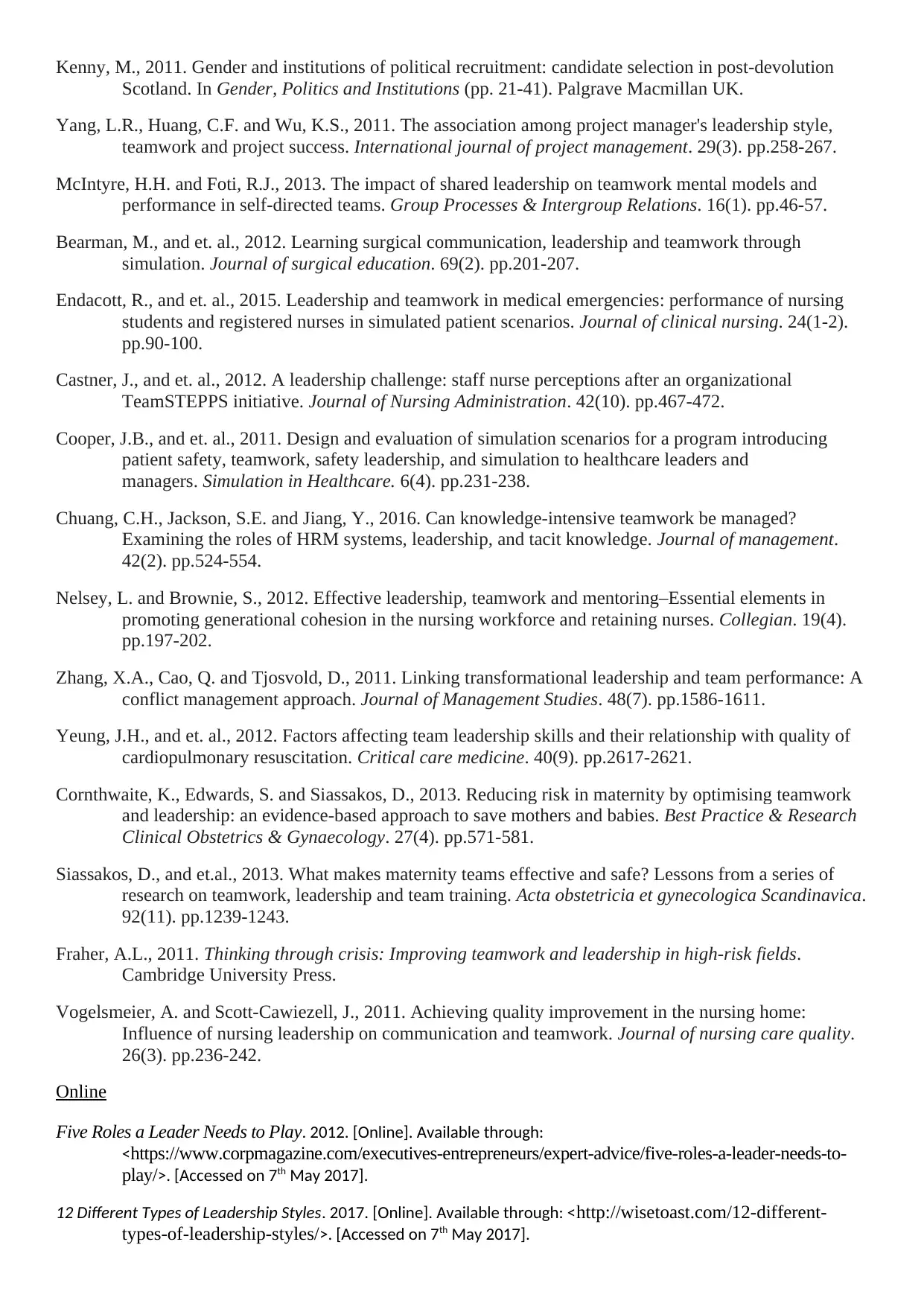
Kenny, M., 2011. Gender and institutions of political recruitment: candidate selection in post-devolution
Scotland. In Gender, Politics and Institutions (pp. 21-41). Palgrave Macmillan UK.
Yang, L.R., Huang, C.F. and Wu, K.S., 2011. The association among project manager's leadership style,
teamwork and project success. International journal of project management. 29(3). pp.258-267.
McIntyre, H.H. and Foti, R.J., 2013. The impact of shared leadership on teamwork mental models and
performance in self-directed teams. Group Processes & Intergroup Relations. 16(1). pp.46-57.
Bearman, M., and et. al., 2012. Learning surgical communication, leadership and teamwork through
simulation. Journal of surgical education. 69(2). pp.201-207.
Endacott, R., and et. al., 2015. Leadership and teamwork in medical emergencies: performance of nursing
students and registered nurses in simulated patient scenarios. Journal of clinical nursing. 24(1-2).
pp.90-100.
Castner, J., and et. al., 2012. A leadership challenge: staff nurse perceptions after an organizational
TeamSTEPPS initiative. Journal of Nursing Administration. 42(10). pp.467-472.
Cooper, J.B., and et. al., 2011. Design and evaluation of simulation scenarios for a program introducing
patient safety, teamwork, safety leadership, and simulation to healthcare leaders and
managers. Simulation in Healthcare. 6(4). pp.231-238.
Chuang, C.H., Jackson, S.E. and Jiang, Y., 2016. Can knowledge-intensive teamwork be managed?
Examining the roles of HRM systems, leadership, and tacit knowledge. Journal of management.
42(2). pp.524-554.
Nelsey, L. and Brownie, S., 2012. Effective leadership, teamwork and mentoring–Essential elements in
promoting generational cohesion in the nursing workforce and retaining nurses. Collegian. 19(4).
pp.197-202.
Zhang, X.A., Cao, Q. and Tjosvold, D., 2011. Linking transformational leadership and team performance: A
conflict management approach. Journal of Management Studies. 48(7). pp.1586-1611.
Yeung, J.H., and et. al., 2012. Factors affecting team leadership skills and their relationship with quality of
cardiopulmonary resuscitation. Critical care medicine. 40(9). pp.2617-2621.
Cornthwaite, K., Edwards, S. and Siassakos, D., 2013. Reducing risk in maternity by optimising teamwork
and leadership: an evidence-based approach to save mothers and babies. Best Practice & Research
Clinical Obstetrics & Gynaecology. 27(4). pp.571-581.
Siassakos, D., and et.al., 2013. What makes maternity teams effective and safe? Lessons from a series of
research on teamwork, leadership and team training. Acta obstetricia et gynecologica Scandinavica.
92(11). pp.1239-1243.
Fraher, A.L., 2011. Thinking through crisis: Improving teamwork and leadership in high-risk fields.
Cambridge University Press.
Vogelsmeier, A. and Scott-Cawiezell, J., 2011. Achieving quality improvement in the nursing home:
Influence of nursing leadership on communication and teamwork. Journal of nursing care quality.
26(3). pp.236-242.
Online
Five Roles a Leader Needs to Play. 2012. [Online]. Available through:
<https://www.corpmagazine.com/executives-entrepreneurs/expert-advice/five-roles-a-leader-needs-to-
play/>. [Accessed on 7th May 2017].
12 Different Types of Leadership Styles. 2017. [Online]. Available through: <http://wisetoast.com/12-different-
types-of-leadership-styles/>. [Accessed on 7th May 2017].
Scotland. In Gender, Politics and Institutions (pp. 21-41). Palgrave Macmillan UK.
Yang, L.R., Huang, C.F. and Wu, K.S., 2011. The association among project manager's leadership style,
teamwork and project success. International journal of project management. 29(3). pp.258-267.
McIntyre, H.H. and Foti, R.J., 2013. The impact of shared leadership on teamwork mental models and
performance in self-directed teams. Group Processes & Intergroup Relations. 16(1). pp.46-57.
Bearman, M., and et. al., 2012. Learning surgical communication, leadership and teamwork through
simulation. Journal of surgical education. 69(2). pp.201-207.
Endacott, R., and et. al., 2015. Leadership and teamwork in medical emergencies: performance of nursing
students and registered nurses in simulated patient scenarios. Journal of clinical nursing. 24(1-2).
pp.90-100.
Castner, J., and et. al., 2012. A leadership challenge: staff nurse perceptions after an organizational
TeamSTEPPS initiative. Journal of Nursing Administration. 42(10). pp.467-472.
Cooper, J.B., and et. al., 2011. Design and evaluation of simulation scenarios for a program introducing
patient safety, teamwork, safety leadership, and simulation to healthcare leaders and
managers. Simulation in Healthcare. 6(4). pp.231-238.
Chuang, C.H., Jackson, S.E. and Jiang, Y., 2016. Can knowledge-intensive teamwork be managed?
Examining the roles of HRM systems, leadership, and tacit knowledge. Journal of management.
42(2). pp.524-554.
Nelsey, L. and Brownie, S., 2012. Effective leadership, teamwork and mentoring–Essential elements in
promoting generational cohesion in the nursing workforce and retaining nurses. Collegian. 19(4).
pp.197-202.
Zhang, X.A., Cao, Q. and Tjosvold, D., 2011. Linking transformational leadership and team performance: A
conflict management approach. Journal of Management Studies. 48(7). pp.1586-1611.
Yeung, J.H., and et. al., 2012. Factors affecting team leadership skills and their relationship with quality of
cardiopulmonary resuscitation. Critical care medicine. 40(9). pp.2617-2621.
Cornthwaite, K., Edwards, S. and Siassakos, D., 2013. Reducing risk in maternity by optimising teamwork
and leadership: an evidence-based approach to save mothers and babies. Best Practice & Research
Clinical Obstetrics & Gynaecology. 27(4). pp.571-581.
Siassakos, D., and et.al., 2013. What makes maternity teams effective and safe? Lessons from a series of
research on teamwork, leadership and team training. Acta obstetricia et gynecologica Scandinavica.
92(11). pp.1239-1243.
Fraher, A.L., 2011. Thinking through crisis: Improving teamwork and leadership in high-risk fields.
Cambridge University Press.
Vogelsmeier, A. and Scott-Cawiezell, J., 2011. Achieving quality improvement in the nursing home:
Influence of nursing leadership on communication and teamwork. Journal of nursing care quality.
26(3). pp.236-242.
Online
Five Roles a Leader Needs to Play. 2012. [Online]. Available through:
<https://www.corpmagazine.com/executives-entrepreneurs/expert-advice/five-roles-a-leader-needs-to-
play/>. [Accessed on 7th May 2017].
12 Different Types of Leadership Styles. 2017. [Online]. Available through: <http://wisetoast.com/12-different-
types-of-leadership-styles/>. [Accessed on 7th May 2017].
⊘ This is a preview!⊘
Do you want full access?
Subscribe today to unlock all pages.

Trusted by 1+ million students worldwide

1 out of 10
Related Documents
Your All-in-One AI-Powered Toolkit for Academic Success.
+13062052269
info@desklib.com
Available 24*7 on WhatsApp / Email
![[object Object]](/_next/static/media/star-bottom.7253800d.svg)
Unlock your academic potential
Copyright © 2020–2025 A2Z Services. All Rights Reserved. Developed and managed by ZUCOL.





